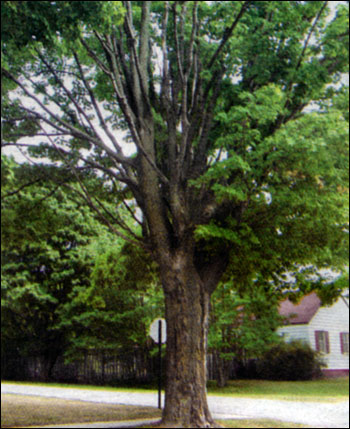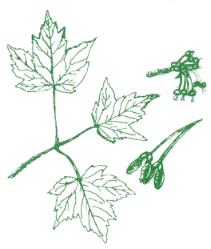As I look upon this refulgent summer I am amazed by the significance trees play in our lives. What first comes to mind as the temperatures soar to the 90s? What great shade! Then thermal dynamics take us up into the leafy bowers and lift not only the sweat from our brown but our spirits as well. We who would praise these qualities of our largest living neighbors must have reverence for them because of our interdependence.

In the same way we trust a newly planted tree to make a healthy start and produce lush growth, the trees trust us for their very survival on our shared ground. Trees planted by people, or put there by nature are a joy to our senses. But when trees don’t look as good as they should we have to ask: what’s up?
Can trees, like people, become stressed? Yes, but that is not always the diagnosis. The rooted nature of a tree allows us to judge its good or adverse environments.
Start by dealing with the competition from other trees either for shade or by using up the available nutrients and water. This kind of s stress is easily managed by providing more space between trees and allowing more room in the canopy for light. Trees that have adequate light may have insufficient water. Do we have inches of rain a week throughout summer? Not this season by a long stretch. Diligently watering your trees can greatly affect their long term survivability and vigor.
Generally a one-inch caliper takes alone year to establish and a three-inch diameter tree takes three years.
Watering with lawn sprinklers is seldom enough for new trees. They need buckets of water frequently to keep the ground saturated. Providing nutrients can not be overlooked for proper growth. Use balanced fertilizers either late fall or during active growth in spring. Use caution not to overfeed and do use tree appropriate plant food. Conifers 9pines, spruces, cedars) use evergreen food. Flowering tress and leafy shade trees use deciduous tree fertilizers.
Damage from lawn mowers and week whackers, or the compression of feeder roots by mechanical equipment and back fill used in driveways are all factors that stress the health of a tree. Mulching one to four feet out from the tree truck can help provide distance from harm. Rodents, deer, and insects can do great damage that is not always obvious. How many times did I look at a slowly dying crab apple tree until I realized, too late, that it was girdled two winters before by some rodent? Deer browse until the ree can lo longer keep up with shoots and leaves. This is particularly tree for certain types of trees like cedar, fruit trees, and many other shrubs and perennials.
Insects invade tress more frequently when one or more of the previous symptoms haven’t been addressed. Most trees with a dose of nurturing are not, and do not become, easy prey for major defoliating attacks. Some problems can be solved vigorous hose spraying with water only, or dish soap and water application.

Looking about as I drove this early evening I saw numerous dead trees along the roadsides: dead elms with their stark vase-like silhouettes; dying and dead Lombardy poplars with their needle-like forms plant as windbreaks; and ancient maples with one-half of the tree in dieback. All these trees have run their course. The poplars just don’t live long. The elms could not hack it and the old maples were planted a120 years ago when shade was indispensable for horse and rider. They’ve out grown themselves. The laws in early last century provided that the 66-foot right-of-ways were planted with shade threes. What good spacing, what great foresight. In this century the giants will need much more care or the will be less common.
One last thought, whether it’s a well-established tree or newly planted, can we identify (by name) the trees we are observing? Do we see a pine or is it a spruce?
Do we know the difference between a hard maple, or a soft maple? How easy is it to identify a birch, yet we seldom take the next step to really know these great creatures. Hopefully the tress in our lives will become like old friends and we will seek them out in all season to re-acquaint ourselves with them.
“It is unwise to rely on the neighbors’ trees for a windbreak. One never knows when the neighbor will decide to cut off the timber.” –Fred C. Sears
Editor’s Note: James Grabowski owns Upland Meadow Landscaping based in Bear Lake, Michigan. Grabowski is adviser to the Tree Board in the City of Frankfort.
This article was originally published during the summer of 2005.




